Articles
| Name | Author | |
|---|---|---|
| Charting an Optimal Course | JD Sillion, Chief Solutions Officer, Flatirons Solutions | View article |
| Moving Day, Getting Ready and Afterwards | David A. Marcontell, President & COO, and John F. Smiley III, Aviation Analyst, TeamSAI Inc. | View article |
| Case Study: New Generation Reporting Tools | Caroline Deba, Reliability Manager, Air Tahiti Nui | View article |
| Case Study: Enhanced Business Operations | Jorma Ryske, Director Finnair IT Aircraft Maintenance | View article |
Case Study: Enhanced Business Operations
Author: Jorma Ryske, Director Finnair IT Aircraft Maintenance
SubscribeEnhanced Business Operations
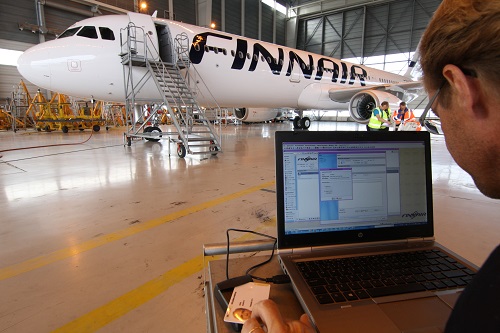
The strategic decision to implement new MRO software is most often triggered by the continuing stresses and strains of operating the legacy system. Switching from a currently working system to a new one is, on the one hand, a financial and operational risk but, on the other hand, offers the opportunity of increasing one’s competitive edge.
Finnair and Finnair Technical Services have for some time been searching the market for an off-the-shelf MRO software solution. This case study will focus on the various stages of the implementation of the solution that we settled on, its impact on day-to-day maintenance operations, the key factors for a successful switch over and some of the issues we discovered during the process.
Initial situation and objective
As its in-house built, almost 30 years old, mainframe based MRO software was outdated, expensive and resource wasting to maintain, Finnair was looking for a new MRO system. After an extensive market search, AMOS came into Finnair’s frame for consideration in light of its integrated approach, modern architecture and user friendliness. The large AMOS customer base (especially in northern Europe) was a further encouraging factor and Finnair / Finnair Technical Services expected to gain additional efficiency in subcontracted maintenance operations.
Challenges faced during implementation
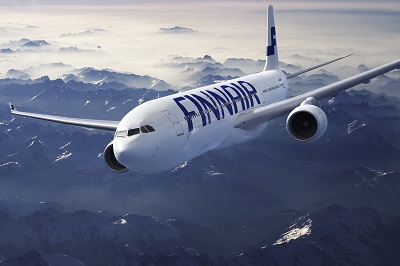 Firstly, Finnair strictly adhered to a zero-customization policy during the definition phase, which meant that the company organization had to undergo several business process changes. And as in almost every project, data transfer was the biggest challenge during the introduction of the new software. The quality of data from the legacy system made it complex for the data transfer team to extract and to transfer the data.
Firstly, Finnair strictly adhered to a zero-customization policy during the definition phase, which meant that the company organization had to undergo several business process changes. And as in almost every project, data transfer was the biggest challenge during the introduction of the new software. The quality of data from the legacy system made it complex for the data transfer team to extract and to transfer the data.
During the implementation period between 2011 and 2012 and also after the Go-Live, Finnair Technical Services underwent significant structural changes as part of the corporate strategic project to enhance the competitiveness of Finnair Group. Services like base maintenance, component maintenance and warehouse operations were almost fully outsourced. These changes affected many internal processes and caused a reduction of about 1,000 employees in Technical Services between 2011 and 2013
Solution, realization and benefit
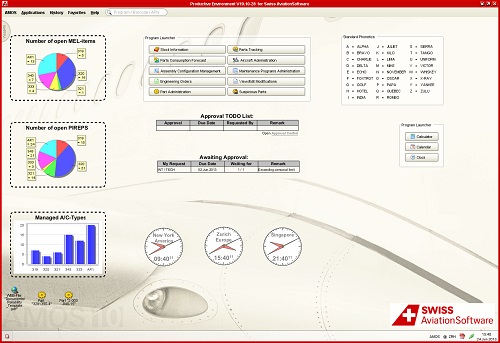
AMOS 10 Main Screen
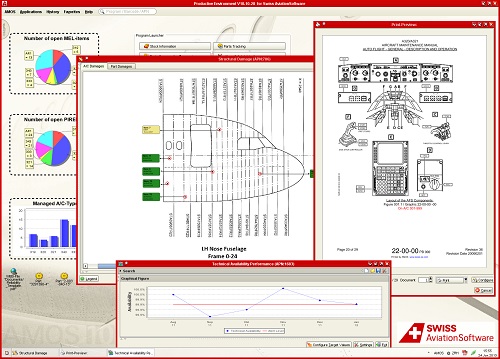
AMOS 10 Various Modules
In order to cope with the legacy system data, the data migration team followed a clear methodical approach. Finnair gave this task significant priority and so assigned a very skilled data transfer team. Several full data uploads were carried out during the project to test, analyze, and measure the data transfer process. This approach turned out to be a success since the ultimate data migration was performed on time and with high levels of accuracy.
Process changes required as part of to the internal enhancement project were fully supported by the MRO software’s functionality and AMOS, including the new processes, was effectively adopted during and after the implementation project without affecting the original project schedule or budget. The project time line was divided into the project definition phase (six months) and the implementation phase (twelve months). The first phase was dedicated to reviewing and defining the usage of the new MRO software in the context of Finnair. The implementation phase was started after approving the go-ahead project plan. The overall project was finished on time and within budget.
Finnair’s implementation strategy was to use the maintenance system without any non-standard, customer specific change requests. Nevertheless, some enhancements to the product were developed based on business requirements that were in line with best practice. In addition, Finnair was able to solve its own customer specific requirements by using the readily available tools in the new software solution, such as interface configurations, web-services, report-designer, etc.
Finnair, being open to new technology and with a tech-savvy reputation, has become an AMOS benchmark customer while being one of the most extensive users across the gamut of AMOS business functions including the most recent enhancements. The M&E software system supports continuing airworthiness, maintenance and other technical services for the Finnair fleet and is used for the management of component repair cycle using almost fully outsourced component repair services. Furthermore, Finnair makes full use of the software modules Shift Planning, Time and Attendance, OEM document management and all engineering related programs such as Weight&Balance, and Software Management.
A core key-user team of 15 FTEs [could this be ‘Finnair Technical Engineers’?] was maintained throughout the duration of the project. Additionally, each Key-User was supported by subject matter experts. From the IT point of view, Swiss-AS supported Finnair’s internal IT department with the ‘AMOS Operational Service’ (AOS) package and thereby helped Finnair to administer the application and its database.
AMOS usage today
As an outcome of the switch-over from the legacy system, many business processes have been optimized in order to adhere to the maintenance software’s industry best practice approach. The feedback within Finnair (600 users in total) in this regard was very positive. The users value the new software as an integrated, user friendly MRO system.
“AMOS provides excellent visibility about fleet maintenance demand that enables effective alignment of aircraft operation and maintenance. The maintenance management system has enabled Finnair Technical Services to make a huge step towards transparency for required resources (consumables, rotables, special tools special requirements, etc.) related to forecast and planned maintenance. Now we have a spare part forecast about needed parts, based on scheduled future maintenance. Also we plan our labor capacity within the new system which allows us to create an overview from one system for aircraft maintenance production, planned workload and labor capacity.” says Mikko Timlin, Director of Maintenance Planning.
One of the most remarkable enhancements was the new process in which the complete airworthiness related data must be updated in the M&E system prior to releasing the aircraft back to service. Essentially, this means that checks, workorders, taskcards, and rotable labels must be updated by the mechanics before they certify the release of the aircraft. The MRO software itself is not prescriptive in this context, but due to the user-friendliness and visibility of data across departmental boundaries, Finnair decided to adopt this process to reap the benefits of up-to-date data made quickly available to all related operations departments.
Furthermore, maintenance production staff processes are all managed in the newly deployed software solution from badge-in/badge-out for time and attendance bookings, to direct data entry and electronic user authentication to update work orders while performing aircraft work based on software generated paper work including AMM tasks, all while using hand-held barcode devices to track working times.
Another highlight is the integrated Spec2000 ordering process (Chapters 2, 3 and 4) which is fully supported by the MRO software system. Further interfaces were established between the M&E software and the existing SAP / Finance and HR. Finally, the rollout at Finnair included integration between the existing aircraft e-TechLog system and the new maintenance software to archive ‘dirty finger prints’. The documents are integrated and linked to AMOS on taskcard level. This real-time integration ensures an efficient defect control and planning process.
Although AMOS has a lot of reports built in, many reports still have to be created to fulfill special needs in any organization. Special reports at Finnair Technical Services are typically created for logistics, manpower handling, defect and reliability reporting areas. The internal Service IT team is creating these new reports with AMOS Report Designer tool or an external reporting tool.
In terms of cost reduction the decision to go for a new M&E software package was also a success since the implementation of the new software has reduced the costs for hosting and license fees for the legacy system by about 75%.
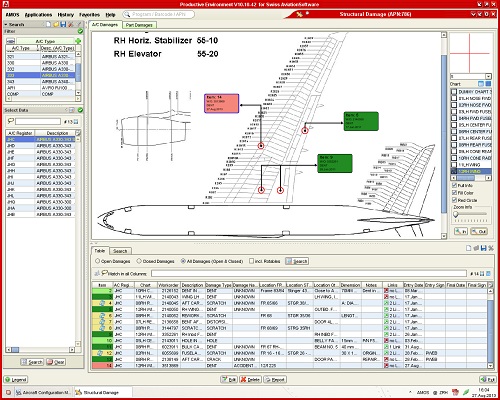
AMOS 10 Structural Damage
Summary and lessons learned
The implementation is considered a success by Finnair and Finnair Technical Services as the risk taken and effort of changing to a newer MRO software system have paid off and the phrase ‘Never touch a running system’ has been proven wrong in this context.
The project review identified several lessons learned from which three major factors contributing to success are explained below:
- Having sufficient and skilled project resources, especially for the data transfer: the amount of time the key users spend on the project should not be underestimated and easily amounts to 80-100% during peak phases. As data transfer is one of the main reasons for project delays, this task was taken very seriously, which was reflected in the selection and number of data transfer experts.
- Having a committed software provider who is also a strong implementation partner: it is of great help if one can fall back on the provider’s experience in introducing the software and its expertise in view of state-of-the-art processes.
- Deployment of the MRO software as-is: in order to reduce the complexity of an IT project it is advisable to avoid customer specific software adjustments (at least prior to the go-live). Experience has shown that early defined customizations often become obsolete or former requirements have shifted once the software is in daily use. In case of AMOS, the needs and requirements of more than 100 customers are covered and Finnair was in the comfortable position to implement a proven off-the-shelf system without the need for major customizations.
In conclusion and umming up the selection, implementation, go-live and subsequent use of the new system, Päivi Mononen, Manager, Resource Planning explained that, “The most important improvements when working with the new MRO software system are the additional functions, data reliability and enhanced data availability compared to the old way of doing resource planning with MS Excel. Also for planning purposes, it is a big benefit to monitor workload and capacity with competencies in the same system. The real time visibility for shift changes and absences is available for all users, and amongst other things, it helps us to keep the working hour calculation up to date.”
Comments (0)
There are currently no comments about this article.

To post a comment, please login or subscribe.